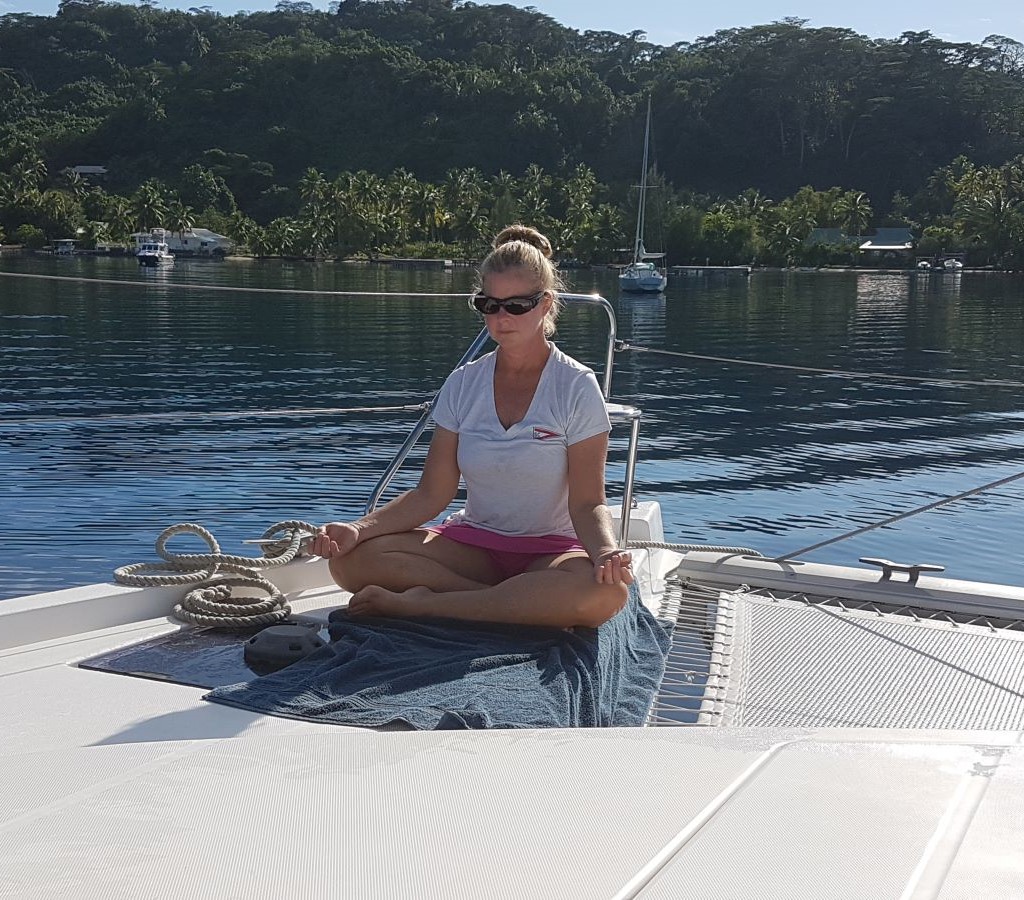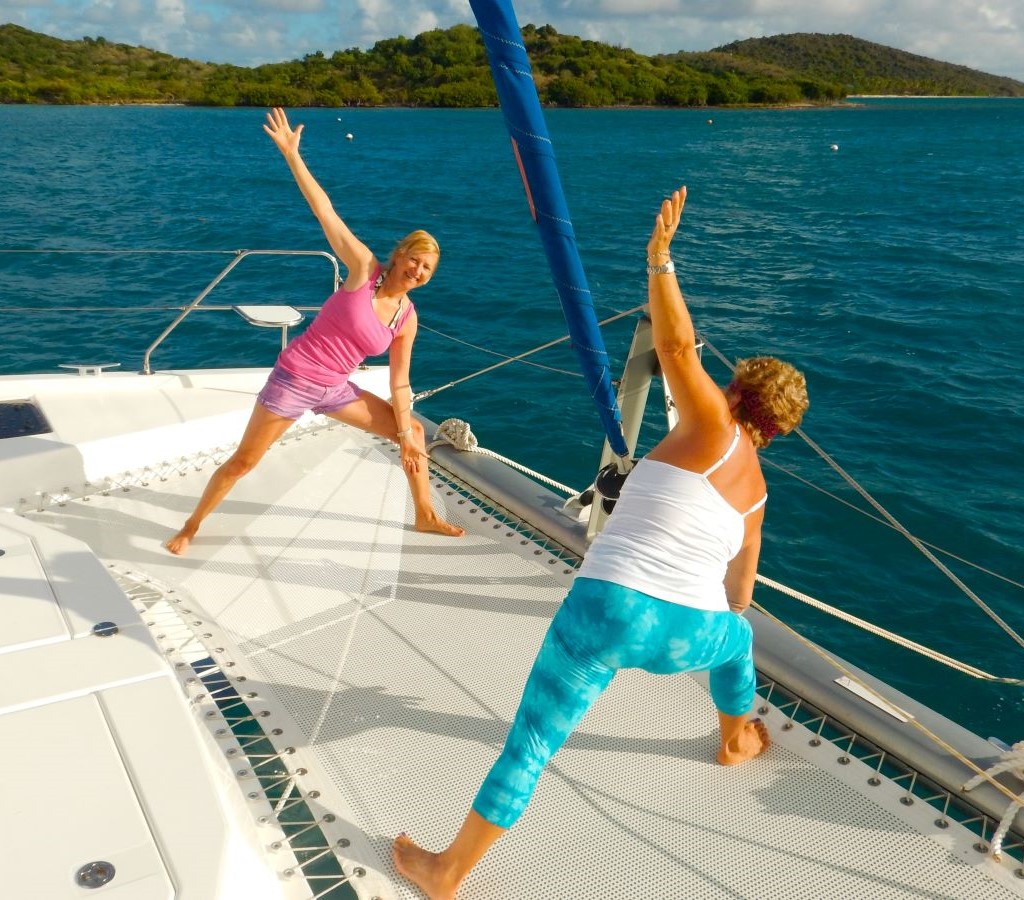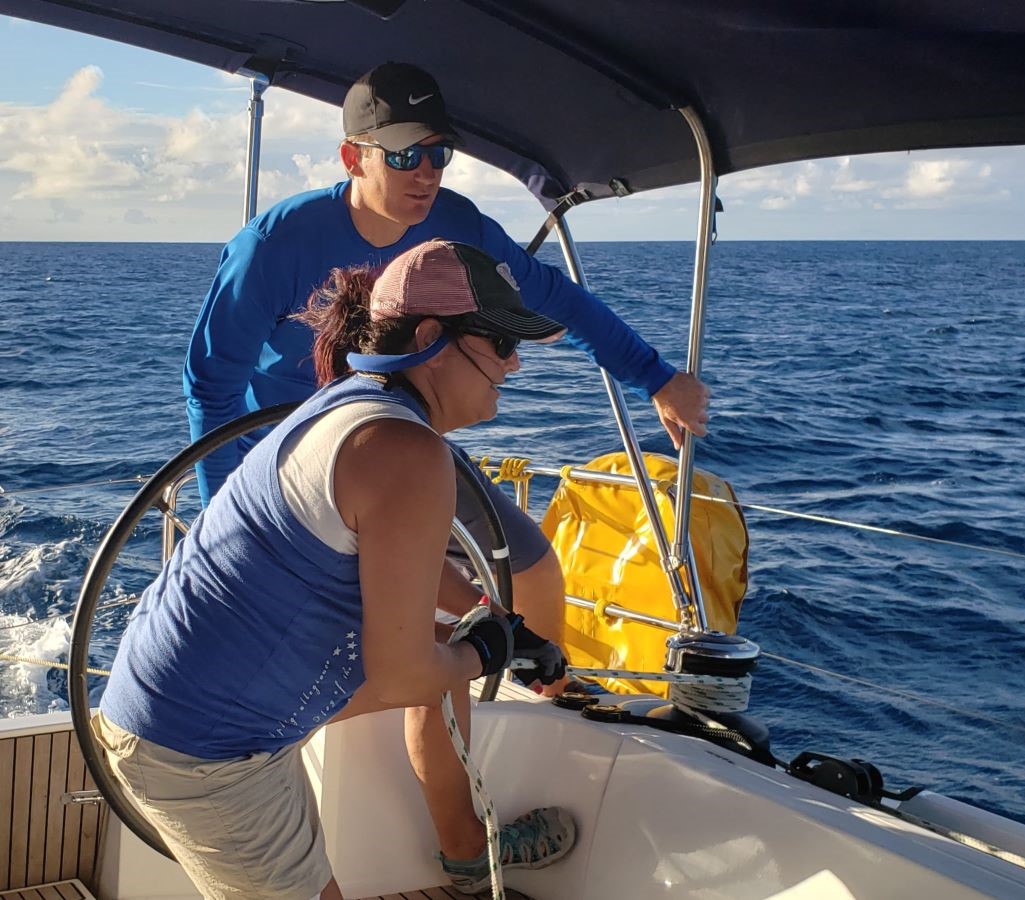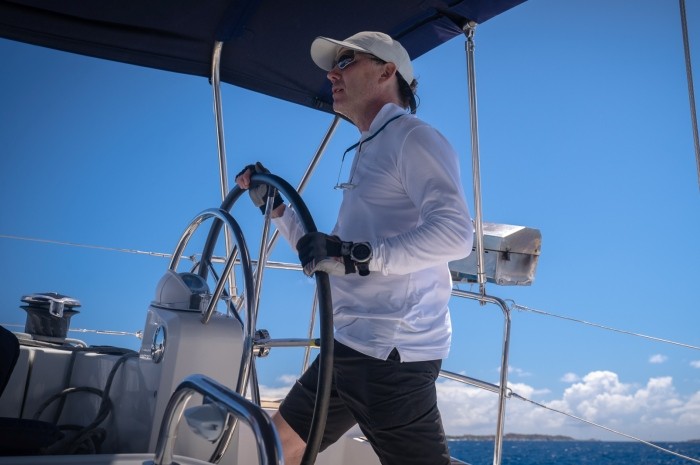One of the wonderful things about sailing is how forgiving it is. You can participate at any exertion level: casual cruiser or hot racer. But during a course, you will do more drills and maneuvers in a short period of time than you would during a normal sailing outing. Chances are, you’ll discover a few new muscles and experience a different kind of fatigue at the end of each day. And you might feel like Deborah Loeff, a pediatric surgeon in Chicago who bought her own boat after her first lesson. “I loved it,” she exclaimed. “Very athletic and mentally challenging.”
If you’re overweight and out of shape, don’t let this hold you back. You might run out of breath pulling lines, and you might feel clumsy getting around the boat at first. But the fact is, it won’t hinder your ability to learn to sail. (However, you might want to think about starting a fitness program when you get home.) Certified instructors are trained to watch for signs of weariness and give you easier jobs or let you rest.
Sailors who race on a regular basis put their bodies through more extremes than casual sailors do, so they need more physical preparation. The 1995 all-women America’s Cup team was up at 5 A.M. running, bench pressing, and developing muscles that matched those of the male team members on other boats. But that’s the extreme.
Women who sail regularly generally emphasize working on upper-body strength and toning exercises for sailing. To compensate for small size or too little strength, Stephanie Argyris recommends learning to use your whole body — your trunk and hips, not just your arms, especially when pulling on lines and using winches when you take one of our US sailing courses at Offshore Sailing School.
Toning your body
While researching this book, I was surprised to find that few women thought about sailing workouts before taking a sailing course. Maybe that’s because fitness is so much a part of our daily lives. If you don’t have a regular exercise regime, I suggest you do a little preparation each day to keep the minor aches at bay. These exercises for sailing can be done wherever you are, at home, on the road, in the gym. But, they might not be for everyone. Check with your doctor, physical therapist or trainer. Get a copy of Fitness Afloat, a video developed for sailors. Start slowly if you haven’t exercised in a while and follow these steps when you begin training for sailing.
Agility and suppleness. Limber up before you go out. Bicycle 5 miles at a good, steady pace on a nice cool morning; use a stationary bike in the gym or at home; do a 10-minute fast walk. Stretch each morning to avoid a pulled muscle or soreness at the end of the day. The following sailing workouts should be done in slow rhythmic repetitions, not sporadic pulsing, always with a flat back and tight stomach and buttocks. Take deep breaths throughout.
- While sitting on the floor with legs wide apart in front, bend as far forward as you can.
- Still on the floor with legs still apart; twist, then stretch low over the right leg, then the left.
- Standing with feet shoulder-width apart, reach as high as you can, over and over.
- Standing, with arms straight out to your sides, twist at your waist as far as you can to one side, then the other.
- With your right arm over your head, your left hand on your hip, lean as far to left as you can. Then reverse.
- Relax your neck and lower shoulders. Keep your hands relaxed at your sides. Now rotate your head slowly down, to the right, to the back, around to the left, and to the front. Reverse and repeat.
Strengthen stomach muscles to avoid back stress. The number of repetitions depends on your stamina. Start with eight of each and build up from there. Keep your back flat on the floor, knees bent, lower legs parallel to floor, stomach muscles and buttocks tight. Alternate flexed ankles with pointed toes to work the muscles in your lower legs.
- Put your hands behind your head, with elbows straight out to the sides, and lift your head up.
- Put your hands behind your head, with elbows straight out to the sides, and lift your upper body, then lower it.
- For these abdominal curls, put your arms straight out behind your head. Raise your upper body and your knees to your chest. Simultaneously bring your arms straight forward, outside your knees.
- For these elbow-to-knee abdominal curls, keep your feet off floor, your arms behind your head with elbows straight out to sides. Curl forward and bring your left elbow to right knee, then right elbow to left knee.
Arms and upper body. When you do standing exercises for sailing, remember to keep your back and shoulders in line, buttocks tucked in,and stomach muscles tight. Legs should not be more than shoulder-width apart.
more than shoulder-width apart.
- In a standing position, with legs shoulder-width apart, hold your upper arms against body, clench your fists, and raise your lower arms up and down from a fully extended position to as tightly bent an elbow as possible.
- Lean forward from your waist with your back flat. Bring your arms tight to your sides and bend your elbows so your lower arms are tight against your upper arms. Tighten your arm muscles, extend your lower arms back, then forward again to closed elbow position.
- Repeat. Try this with small weights in your hands too.
- Squeeze a tennis ball in each hand repetitively.
- Using small weights or soup cans, extend your arms and roll your wrists.
Upper body and chest muscles. Holding small weights or soup cans will augment these sailing workout exercises. Always keep your back straight, and your stomach and buttock muscles tight.
- With your arms straight out to your sides, at shoulder height, bend your elbows and keep your lower arms straight, so your arms make an L-shape. Bring your arms across chest until your hands and forearms meet. Return to your starting position. Repeat.
- With your arms straight out to your sides at shoulder height, palms open and facing down, bring your arms across your chest and each other fully extended; pulse two times. Stretch arms back to starting position fully extended; turn palms away and pulse two times back as if you were pushing against a wall. Repeat.
Leg muscles. Remember: For all the leg sailing workout exercises, keep your buttocks tight (you get a little boost in shaping that area too), back straight, and stomach muscles tensed.
- On the floor on your back, raise your buttocks and legs straight up.
- Support your lower back with your hands. Pump your legs fast, as if bicycling; alternate pointed toe and flexed ankles.
- Standing facing a chair, door, or rail, hold onto the chair back, door knob, or rail with both hands. Raise your outside leg in front of you, with thigh as close to a right angle with the floor as possible, your knee bent, and your leg hanging straight down. Keeping this position, open your hip, and move your leg as far to your side as possible without twisting at the waist. Holding this position, extend your lower leg straight out, then bring it back to a bent position. Alternate pointed toes and flexed foot. Repeat. Change sides and work your other leg.
- Facing a chair back or a rail, hold on with both hands, tighten your legs, raise yourself up on your toes, and lower yourself down several times.
Exercises aboard
Diana Smith, an avid racer and NWSA founding member, carries a 6-foot length of ¾ inch surgical tubing wherever she goes. On a boat, she hangs it over the boom or over handholds in the cabin below and pulls against it to strengthen her shoulders and upper back. For a simulated pectoral machine, she wraps it around a vertical post and sits with her back to the post, pulling the ends to the front. To simulate a rowing machine, she sits with feet extended and wraps the tubing around her soles.
Women who cruise over long distances find their bodies become sinewy and strong. They tend to eat less and consume healthier food. With no real deadlines, stress levels fade away; you feel younger and better. There are all kinds of exercises for sailing you can do when cruising, using various parts of the boat — the boom and handholds for stretching; bungee cords, winch handles, halyards and lines for upper body; foredeck surface and cockpit seats for leg work and abdominals. Cans of food work well as weights. The day-to-day activity of cruising is a workout in itself. You tense and relax muscles as you balance against the boat’s movements, bend and pull on lines, row dinghies, and swim.
Reprinted from “Sailing – A Woman’s Guide” By Doris Colgate Published by Ragged Mountain Press
Sailing is a dynamic sport that can demand a unique combination of strength, flexibility, endurance, and mental acuity.
Incorporating a structured sailing workout regimen into your routine can significantly improve your abilities and overall enjoyment of the sport.
The Importance of Physical Fitness in Sailing
At Offshore Sailing School, we emphasize that physical fitness is a key component of becoming a skilled and confident sailor. Whether you’re handling sails, balancing on a heeling deck, or enduring long hours at the helm, sailing challenges various muscle groups and cardiovascular endurance. A well-rounded fitness program tailored to sailing can lead to:
- Improved Muscle Strength: Essential for tasks like trimming sails and maneuvering equipment.
- Enhanced Flexibility: Aids in efficient movement around the vessel, reducing the risk of injury.
- Increased Stamina: Vital for maintaining focus and performance during extended periods on the water.
- Better Balance and Coordination: Crucial for stability on a moving boat, especially in rough conditions.
By focusing on these areas, sailors can ensure they are physically prepared to meet the demands of sailing when in heavy winds and rough seas.
Essential Exercises for Sailing
To develop the necessary physical attributes, consider integrating the following sailing exercises into your fitness routine:
1. Core Strengthening
A strong core is fundamental for maintaining balance and executing movements efficiently on a sailing vessel.
- Planks: Hold a plank position for 30-60 seconds, engaging the abdominal muscles.
- Russian Twists: Sit on the floor with knees bent, lean back slightly, and rotate your torso side to side while holding a weight.
- Leg Raises: Lie on your back and lift your legs to a 90-degree angle, then slowly lower them without touching the ground.
Incorporating these exercises enhances stability and control during various sailing maneuvers.
2. Upper Body Conditioning
Strengthening the upper body is crucial for tasks such as hoisting sails and steering.
- Pull-Ups: Develop back and shoulder muscles essential for pulling actions.
- Push-Ups: Target the chest, shoulders, and triceps, promoting pushing strength.
- Dumbbell Rows: Focus on the upper back, improving posture and pulling power.
Regular upper body training ensures you can handle the physical demands of sailing with ease.
3. Cardiovascular Training
Endurance is key for long days on the water.
- Running or Jogging: Enhances cardiovascular health and leg strength.
- Cycling: Provides a low-impact alternative to improve stamina.
- Swimming: Combines cardio with full-body conditioning, mimicking the aquatic environment.
Engaging in cardiovascular activities prepares your body for the sustained effort required during sailing excursions.
4. Flexibility and Balance
Flexibility and balance are vital for moving efficiently and safely on a boat.
- Yoga: Combines stretching with balance poses, enhancing overall flexibility.
- Balance Board Exercises: Mimic the unstable surface of a boat, improving proprioception.
- Dynamic Stretching: Incorporate movements that stretch muscles through their full range of motion.
These practices help prevent injuries and improve your ability to adapt to the boat’s movements.
 Strength Training for Sailing Performance
Strength Training for Sailing Performance
Building muscular strength through strength training exercises is vital for sailors. Incorporating strength gains into your routine enhances endurance and prevents fatigue during long sailing trips.
Key Strength Training Exercises for Sailors
To develop upper body strength, core strength, and lower body endurance, include the following:
- Pull-ups and Chin-ups: Improve arm strength and grip for handling sails and rigging.
- Deadlifts: Enhance total-body power, especially useful for lifting heavy equipment.
- Planks and Russian Twists: Strengthen core muscles for balance and control.
- Lunges and Squats: Develop leg muscles for stability and agility on deck.
- Farmer’s Carry: Increases grip strength and mimics carrying heavy gear on a boat.
By consistently following a strength training regimen, sailors can develop endurance and stamina, reducing the risk of injury and enhancing the performance of sailors in various conditions.
Water Training for Sailing Fitness
To complement sailing exercises, incorporating water training adds a realistic element to fitness regimes. This type of training improves coordination, endurance, and adaptability to shifting conditions on the water.
Effective Water Training Drills
- Treading Water: Enhances core strength and endurance for long sailing hours.
- Swimming Drills: Develops cardiovascular exercise capacity for high-energy tasks.
- Balance Board Exercises on Water: Improves stability, simulating deck movements.
- Kayaking or Rowing: Strengthens upper body strength and enhances grip strength.
Regular water training prepares sailors for real-world conditions, helping them adjust to the physical demands of different sailing environments.
Start Your Sailing Training Program Today!
Enhancing sailing fitness through a structured training for sailing program improves both safety and performance on the water. By integrating core exercises, strength training, cardiovascular exercise, and sailing practice drills, sailors can develop the strength, endurance, and agility needed for an exceptional sailing experience.
Ready to elevate your sailing skills? Offshore Sailing School offers hands-on sailing courses at locations in Florida and the British Virgin Islands. Join our sailing programs today to combine technical training with real-world sailing practice and become a confident, well-prepared sailor!
Frequently Asked Questions
Why is strength training important for sailing?
Strength training is essential for sailors because it enhances muscular strength, endurance, and stability on the water. Sailing requires a combination of upper body strength for handling sails, grip strength for rope work, and leg muscles for balance on an unstable deck. Regular strength training exercises improve performance, reduce fatigue, and prevent injuries, making sailing more efficient and enjoyable.
What are the best sailing exercises to improve core strength?
Developing core strength is crucial for maintaining balance and stability while sailing. Some of the most effective core exercises include:
- Planks: Strengthen the entire core for better posture and endurance.
- Russian Twists: Improve rotational strength needed for maneuvering sails.
- Leg Raises: Help with flexibility and lower abdominal endurance.
- Deadlifts and Farmer’s Carry: Build full-body strength while enhancing grip strength.
Incorporating these into a sailing workout ensures sailors can handle rough waters with better control.
How does cardiovascular exercise benefit sailing performance?
Cardiovascular exercise plays a key role in training for sailing, as it increases stamina and endurance, allowing sailors to perform for extended periods without fatigue. Activities such as:
- Running or cycling: Improve heart health and leg endurance.
- Swimming: Mimics movements used in water training, strengthening both upper and lower body muscles.
- Rowing or kayaking: Builds endurance while targeting upper body strength.
A well-balanced fitness regime with cardiovascular exercise ensures that sailors have the energy and stamina for long hours at sea.










